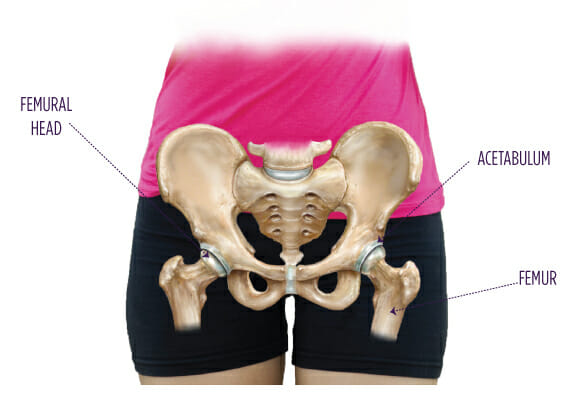Hip anatomy overview

The hip is a ball-and-socket joint.
- The ball portion is the rounded head of the femur (thighbone).
- The socket is the shallow cup called the acetabulum.
- These surfaces are coated in articular cartilage, which is a smooth, gliding surface.
The joint is surrounded by a capsule or lining that provides support. Finally, muscles and tendons move the hip through various ranges of motion. There are bursa sacs located throughout the muscles and tendons that help lubricate these surfaces. The structures work together to provide hip stability and the range of motion necessary for activity.
How are hip injuries diagnosed?
The diagnostic process starts by talking with you about your symptoms and conducting a detailed physical examination. Diagnostic imaging, including X-rays and MRI scans, can be useful for a diagnosis as well.
What are the symptoms of a hip injury?
Symptoms of a hip injury include:
- Pain in the groin and during the night
- Painful clicking and/or popping
- Pain and/or weakness with certain movements
- Possibly pain that radiates into the thigh
- Inability to bend at the hip
What are the treatment options for hip injuries?
Anti-inflammatory medicines: Over-the-counter medications such as Aleve, Advil, Motrin, and aspirin can help reduce swelling and pain.
Injections: In the specialist’s office, medication is injected directly into the joint. Injections can provide lasting relief of pain and swelling.
Physical therapy: A therapist can work with you to improve core and gluteal strength and to teach proper hip mechanics.
Wellness: Start with a free wellness consultation to explore your goals and what tools are available to you.
Integrated physical therapy and wellness: Our team of physical therapists, performance specialists, and registered dietitians works collaboratively with you to design an integrated rehabilitation plan that will help you reach your full potential.
Surgery: If you fail to improve after nonsurgical care, your specialist may wish to intervene surgically. Your specialist can discuss the details of the surgery with you should it become necessary.
More resources for you
- Discover Summit’s comprehensive arthritis care
- Read about the causes of knee and hip joint pain
